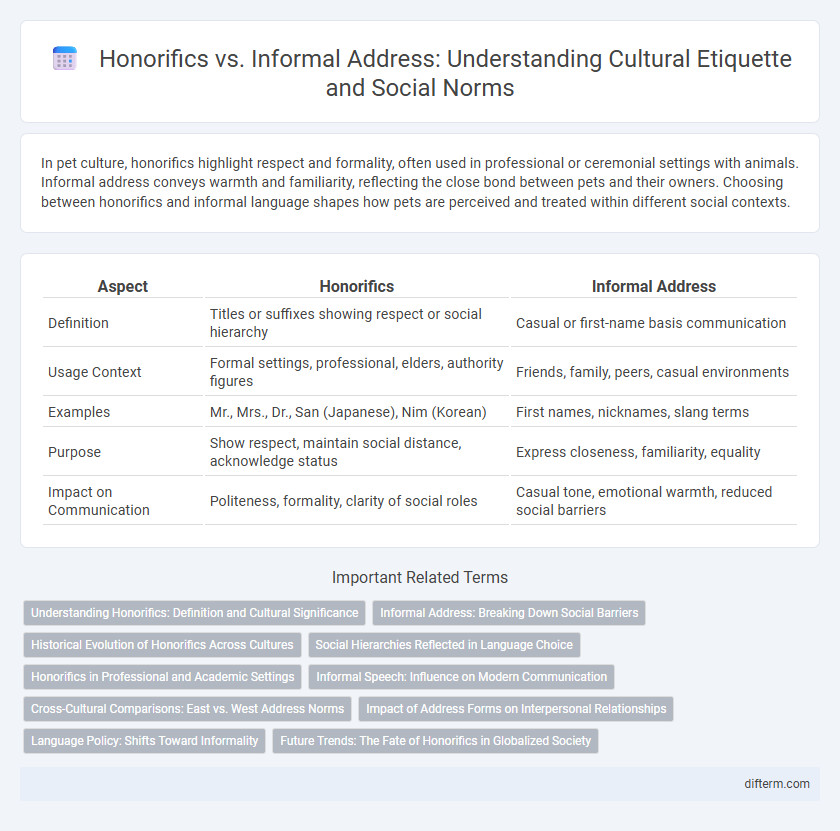In pet culture, honorifics highlight respect and formality, often used in professional or ceremonial settings with animals. Informal address conveys warmth and familiarity, reflecting the close bond between pets and their owners. Choosing between honorifics and informal language shapes how pets are perceived and treated within different social contexts.
Table of Comparison
| Aspect | Honorifics | Informal Address |
|---|---|---|
| Definition | Titles or suffixes showing respect or social hierarchy | Casual or first-name basis communication |
| Usage Context | Formal settings, professional, elders, authority figures | Friends, family, peers, casual environments |
| Examples | Mr., Mrs., Dr., San (Japanese), Nim (Korean) | First names, nicknames, slang terms |
| Purpose | Show respect, maintain social distance, acknowledge status | Express closeness, familiarity, equality |
| Impact on Communication | Politeness, formality, clarity of social roles | Casual tone, emotional warmth, reduced social barriers |
Understanding Honorifics: Definition and Cultural Significance
Honorifics are titles or expressions of respect used in speech and writing to convey social hierarchy, politeness, or formality, deeply rooted in cultural traditions across societies such as Japan's keigo system or Korea's use of "ssi" and "nim." Understanding honorifics requires recognizing their role in maintaining social harmony, reflecting values like respect for elders and authority, and signaling relationship dynamics. Mastery of these linguistic forms enhances cross-cultural communication and prevents social faux pas in diverse cultural contexts.
Informal Address: Breaking Down Social Barriers
Informal address plays a crucial role in breaking down social barriers by fostering a sense of equality and approachability. It reduces hierarchical distance, encouraging open communication and stronger interpersonal connections across different social groups. This shift towards casual language reflects changing cultural norms that prioritize inclusivity and mutual respect over rigid formality.
Historical Evolution of Honorifics Across Cultures
Honorifics have evolved through centuries as markers of social hierarchy, reflecting the values and power dynamics within various cultures worldwide. From the elaborate titles used in feudal Japan to the more streamlined forms in contemporary Western societies, these linguistic forms demonstrate shifting norms in respect and authority. Informal address, often emerging alongside democratization and modernization, contrasts with honorifics by fostering egalitarian communication and diminishing rigid social stratification.
Social Hierarchies Reflected in Language Choice
Honorifics in language serve as markers of social hierarchy, signaling respect and deference to individuals of higher status, age, or authority within a community. Informal address often reflects closeness, equality, or familiarity, emphasizing personal relationships rather than social rank. The choice between honorifics and informal terms reveals underlying social structures and cultural values governing interpersonal interactions.
Honorifics in Professional and Academic Settings
Honorifics in professional and academic settings convey respect and establish hierarchy, such as "Dr.," "Professor," or "Mr./Ms." These titles enhance clarity and formality, ensuring appropriate recognition of expertise and status. Using correct honorifics fosters courteous communication and upholds institutional norms.
Informal Speech: Influence on Modern Communication
Informal speech, characterized by the use of casual language and the omission of honorifics, significantly shapes modern communication by fostering a sense of equality and approachability. Digital platforms and social media amplify this trend, encouraging more direct and succinct exchanges that prioritize efficiency over traditional formalities. This shift reflects broader cultural changes toward personalization and the breakdown of hierarchical barriers in everyday interactions.
Cross-Cultural Comparisons: East vs. West Address Norms
Honorifics in East Asian cultures such as Japan and Korea emphasize respect and social hierarchy, often dictating language structure and usage in daily interactions, while Western cultures like the United States and Australia favor informal address that reflects egalitarian values and personal freedom. The use of titles and formal speech in Eastern societies signifies social roles and relationships, contrasting with Western preference for first names and direct communication. This divergence highlights how cultural values shape linguistic etiquette and interpersonal dynamics across global contexts.
Impact of Address Forms on Interpersonal Relationships
Honorifics convey respect and social hierarchy, reinforcing positive interpersonal dynamics by acknowledging status and formality. Informal address fosters closeness and solidarity but may risk diminishing perceived respect in hierarchical contexts. Choosing appropriate address forms significantly influences communication effectiveness and relationship building across diverse cultural settings.
Language Policy: Shifts Toward Informality
Language policy reforms in various cultures increasingly promote informal address, reflecting societal shifts toward egalitarian communication. Honorifics, traditionally embedded in linguistic structures to signal respect and social hierarchy, are being reevaluated for their relevance in modern contexts. This trend influences language education and official discourse, encouraging more inclusive and accessible communication styles.
Future Trends: The Fate of Honorifics in Globalized Society
Honorifics face evolving roles in globalized society as digital communication and multicultural interactions blur formal boundaries. Informal address gains prominence through social media and cross-cultural exchanges, promoting inclusivity while challenging traditional hierarchies. Future trends suggest a hybrid approach where honorifics coexist with informal language, adapting to context and cultural sensitivity.
honorifics vs informal address Infographic

 difterm.com
difterm.com